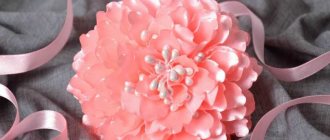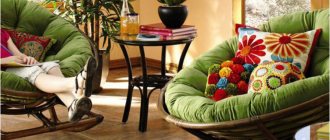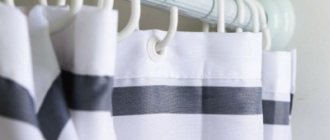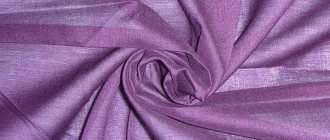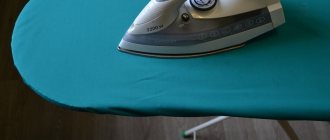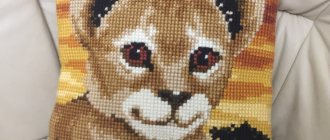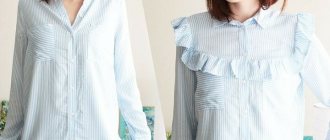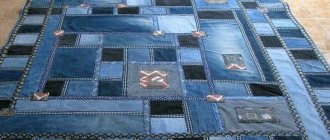Today, designers not only introduce new and original trends, but also constantly return to their roots. The same thing happened with buffers. They have found new life and “sparkled with bright colors” thanks to modern fabrics and textures. In the Middle Ages, such window decoration was the privilege of only the nobility, as it was very expensive. In the modern world, you can afford this even with a small budget, if you know how to make a buffer for curtains with your own hands, without the help of designers and without special financial costs.
Using buffers in a modern interior
Most often, such decorative folds are used in rooms where the interior is made in a classic style with massive furniture, gilding and monograms.
However, they look very original and extraordinary in the Art Nouveau style. In this case, the difference will only be in the design of the fold itself. They can be made more lush and airy.
Peculiarities
Puffs are tucks and folds in the fabric, made in the form of non-standard drapery methods. The result is textile compositions with a touch of luxury and exquisite romanticism. They are appropriate in the design of bedrooms for women or married couples, in the decor of formal offices or formal living rooms.
The technique that allows you to sew puffs on curtains comes from France, where it was first used by local needlewomen. Its essence is revealed in the translation of the word bouffer, meaning “to blow up.” From the very beginning, these lush elements were used to decorate the clothing of noble people. A little later, with the coming to power of Louis XIV, puffs began to be used to decorate luxurious rooms. And today anyone can sew ruffles on curtains.
Flounces on curtains are most often sewn from the inside of the fabric, only some elements are made from the front. At the same time, in order to get an intricate ornament, be sure to adhere to the pattern according to which the stitches are made.
This design method allows you to assemble lambrequins and puffs into artistic folds, which gives the room a festive, even slightly theatrical atmosphere. Large puffs make a pompous impression and are suitable only for rooms decorated classically. A tall window decorated with long floor-length curtains is considered ideal. If the window is decorated with small folds, then they are also appropriate in small spaces.
Types of buffers
There are only two types of such decorative folds:
- Those made in production;
- Those that are made independently.
The only difference between them is that manual work requires a lot of time and perseverance. As for factory production, you will receive finished work in the shortest possible time.
Today the most popular buffer configurations are:
- Rhombus,
- Braid,
- Zigzag,
- Basket,
- Hungarian embroidery,
- English folds,
- "Waffle cake",
- Various types of flowers.
They get their names from the shape of the fold they end up with.
Important!
In addition to curtain designs, puffs can be sewn onto pillows and blankets.
"Flowers"
Let's consider the algorithm for executing the "Flowers" scheme:
It is also necessary to mark on the inside. One bead is needed for each flower. On the outside, you need to make a “square” shape using stitches. Next, you need to pull the thread and sew through the tie section.
After this, you need to insert the bead. Next, you should bring the thread to the inside of the fabric and tie a knot. This will secure the assembly. Then you need to insert the needle into the closest point to create another flower.
You definitely need to tie a knot. Then you need to bring the needle to the outer part of the fabric to stitch the “square” shape again. After this, it is necessary to tighten and repeat the fixation on the inside. The process must continue. Assemblies must be repeated and recorded.
How to choose fabric for buffers?
- For curtains with pleats, it is best to choose lightweight fabrics.
Important!
Try to pay attention to materials that have a metallic shimmer. Thanks to this fabric decor, the future fold will “play” in a new way.
- If your choice fell on transparent fabrics, then they should be interspersed with various inclusions of lurex or other mother-of-pearl thread. Thanks to this combination, you can create beautiful iridescence.
- For lovers of monochrome color, you should make the fold on the curtain less voluminous. This way you can avoid the effect of crumpled curtains.
- Choose contrasting fabrics that will harmonize and highlight the finished product.
Areas of application for buffs
Puffs are a unique textile decor that can be used in any area. Some designers use the technique to decorate clothes, others decorate furniture upholstery in this style.
Buffs for finishing fabric
Where can you use this decorative technique:
- On collars, belts of clothes.
- Linen pillowcases on sofa cushions.
- On curtains, curtains and lambrequins.
- You can decorate the bedspread with a pattern.
- On hats, headbands, scarves.
- Bags, wallets, cosmetic bags.
- Ottomans, furniture covers.
Puffs on clothes
You can use puffs for finishing any types of textiles that have decorative functionality.
Necessary materials
You can sew curtains with buffers without using a sewing machine. But, despite this advantage, it is worth stocking up with quite a large number of auxiliary tools:
- Sewing needles (note that these need to be quite long).
- Threads. They should be the same color as the fabric.
- Sewing pins with colored heads.
- Curtain tape.
- Chalk or a special sewing marker.
Important!
Chalk or tailor's marker can be replaced with a bar of soap. It draws well, but is easy to erase and leaves no marks.
- Tape measure.
- Long ruler.
- If available, a sewing machine.
detailed instructions
How to make gathers on fabric? To carry out assembly, you must use a strong thread. The color of the thread should also be combined with the tone of the selected product.
The needle should be inserted and removed so that the point is in the middle.
Next, you need to tighten the thread so that the folds can “stand”, but at the same time they can be moved to the central part without any problems. The ends of the threads must be tied into a strong knot.
Then another puncture is made under the starting point. The rows are made in the form of a zigzag. The thread needs to be pulled again to make a knot.
Subsequently, all technology is similar. Nodes are created downwards, moving along the row. All threads should lie in a zigzag pattern.
There are various options for buffing schemes:
- In the form of a wave (inner side); flowers (inner side); spike pattern (inner side); floral (outer side); basket (inner side); bamboo (wrong side); braid (wrong side); braided (wrong side );
There are other options for making puffs, it depends on the person’s preferences. Master class on making puffs - let's look at step-by-step instructions for some schemes.
Calculation of the required number of buffers
The number of elements depends on the width of the future curtains. To do this, you need to multiply the length of the cornice by 2.5. The number you get will be the length of fabric you will need.
Important!
Always consider the amount of fabric that will go into the side cuts. Therefore, 10-20 centimeters should be added to the total amount of material.
Once you have calculated the amount of fabric, you can find out the number of future folds. To do this, you need to divide the width of the canvas by the width of the future element.
Then the width of the future lambrequin is calculated. It is calculated by summing the following indicators:
- You need to multiply the height of the element by the future number of rows.
- Calculate the future width of the curtain tape, adding about 2-3 centimeters for allowances.
- You should also calculate the allowance for the bottom edge (about 2-6 centimeters) and the fold width for the bottom cut (5-7 centimeters).
Master class decorative pad puffs - puff patterns
Good afternoon, I want to share my experience with you, I’ll show you how to make a pillowcase for a sofa cushion. Buffs.
This buffer is going to be 1:1.5, it is better to take a higher coefficient, for example 1.8. This means that for a 50*50 pillowcase I took 85 cm of fabric, do not forget about the seam allowances. I’ll write about the pillowcase I made, then you can take any sizes yourself at your discretion.
Here are the patterns of the puffs, called flowers. It turns out to be a very interesting buffet. This version of the puff is assembled first along the wrong side of the material, and then along the front. Apply the pattern to the wrong side.
Building a circuit with the following layout
In order to make buffers on the curtains, you should draw a preliminary diagram. Thanks to this, the sketch can be transferred from paper to fabric as accurately as possible. The drawing should consist of dots and arrows (direction from one point to another).
Important!
The transfer of the design onto the fabric should be done exclusively from the wrong side.
Always use a ruler while working. This is necessary to ensure that the distance between the marks is equal.
Important!
Please note that various errors may occur when moving the image. To prevent the drawing from becoming skewed, the elements of the diagram must be applied in parallel.
Rules for designing buffs
You can decide how to make the puffs on the fabric neat and correct in a matter of seconds. You need to know a few secrets of creating folds and the rules of working with a needle. The basic rules are a few nuances:
- The distance between the elements of the pattern should be determined by the size of the base fabric. Usually only 1.5-2.5 cm between the needle penetration points is sufficient.
- When transferring the diagram to the fabric, you need to set not only points for the needle, but also indicate the direction of work.
- It is advisable to tighten the thread so that a “stable” but soft fold is obtained.
- When the thread passes through the point, you need to fix it by making several knots at the base.
- The pattern is located in the center of the product; it can become a frame or a side strip for decoration.
- You can hide uneven stitches and divert attention from the supporting work by using decorative elements: beads, seed beads, sequins.
Basting
After the design is transferred to the fabric, you can begin the process of sewing the buffers. If you do the work manually, then know that it is quite painstaking, so please be patient:
- First, thread the needle;
- Insert the needle and thread into the first point, but you should not pull it out all the way.
- The “tail” that you have left should be at least 4 centimeters. The base is secured with a knot.
- The remaining part of the thread should be inserted into the point located on the diagram at the arrow entrance.
- We stretch it so that the first tail of the thread and the last are connected. After this, they are connected and secured with several knots.
- Next, all work is done with each arrow separately on the entire canvas. As a result, on the front side you have formed assemblies, which are called buffers.
Important!
Such protections should not be made over the entire canvas. You can only decorate the top or edges this way.
Kinds
Since ancient times, the technique of gathering fabric, giving it volume, is called puffs, tucks. Professionals believe that this is a simple job, but it requires perseverance:
- On the back side of the curtains, a special pattern is applied using dots;
- After they are sewn in the required order, tucks (curly folds) appear on the fabric;
- Thanks to this method, it is possible to make figures of various types.
DIY drawing of curtains with puffs: original solutions
We bring to your attention some simple but interesting ideas on how you can decorate windows using buffers.
Original decor with a simple zigzag
For this option, the first thing to do is measure the fabric. To make the calculation, you need to multiply the required height of the curtains by a multiple factor. The width of the fabric cut is calculated using the same formula.
Important! The universal index for all types of fabrics is 2.5. Depending on the taste and volume of the future buffer that you need, the coefficient can be changed to a greater or lesser extent.
Let's get started:
- Lay your canvas face down.
- Divide the cut width into an even number of strips of the same width. Step back 15 centimeters. Mark each stripe.
- Place dots along the first strip at a distance of 15 centimeters from each other.
- Do the same on the second stripe. The only thing is that you need to place dots between the marks of the first row to get a checkerboard pattern.
- You need to gather the folds along the first line. To do this, insert the needle and thread into the first point of the first row and grab the fabric down the line. Every 2.5 centimeters must be connected and secured with a knot.
- When you finish the first row, feel free to move on to the second. Follow the same pattern.
There are various ways to make curtain buffers. You can decorate them both on the wrong side and on the front side, or experiment with fabrics. But in order for you to succeed, you must adhere to several rules:
- Always consider the weight and texture of the fabric. It is best to choose light and medium materials.
- When choosing fabric, you should always remember that in order to tighten dense fabrics you need to apply force and purchase very strong yarn. Tightening lightweight fabrics does not require much effort, and the resulting pattern will be lighter and airier.
- Choose single-color curtains.
- To make buffers, use thread twice as dense as for sewing curtains.
- Buy a set of needles of different lengths.
- If you are a beginner, then do not choose complex schemes.
You don't have to be a noble aristocrat to decorate your window with buffers. Thanks to the above recommendations and rules, you can create a decor that Louis XIV himself would envy. The main thing is to have a little patience and persistence. And then everything will work out for you.
Let's understand the terminology
Lambrequin location diagram.
The French word “lambrequin” is usually used to describe a decorative fabric cornice. Why is it needed for curtains? It perfectly camouflages the top of the window. It is located on top of the curtain. It is usually made from fabric of the same color or texture or contrasting fabric. Lambrequins are usually divided into soft and hard. This depends on the presence of a lining that provides the appropriate property. Lambrequins play a special role in the functional and aesthetic space of a house or apartment. They change the visual perception of the size of the window opening. With their help, the window frame appears larger than it actually is. Lambrequins visually increase the space of rooms, which is especially important when it comes to small housing.
Lambrequins are divided into simple and complex; the criterion by which gradation occurs is swags - hanging folds of fabric. The width, height, and number of swags determine the fabric consumption and the complexity of making the curtains yourself. Curtains that combine soft and hard lambrequins are very fashionable in interior design. However, it is quite difficult for beginning craftswomen to complete them. Experienced seamstresses usually recommend sewing a curtain that will be decorated with a simple soft lambrequin, and only then moving on to more complex designs. Sewing lambrequins using the puff technique is popular among those who are taking their first steps in the art of sewing. Puffs is also a French word that denotes the condition of the fabric if it puffs up, inflates, that is, takes on a different three-dimensional shape.
Puffs are a classic of interior design; they can be used to decorate not only curtains, but also other items.
A very stylish solution is considered to be the option when curtains and sofa cushions are decorated with puffs made of a single-color, single-texture fabric.
Related article: Warm water floor: on a wooden base, how to lay a board, laying and installation using Finnish technology
Lambrequins with puffs are sewn quite simply.
There are different types of making puffs. But if you choose the simplest one and make lambrequins using this technique, then the most discreet curtain will look elegant. If you decide to make such a lambrequin, the puffs will change the space of the usual room, and the curtain in it will look new. Sewing puffs with your own hands is not as difficult as it seems at first glance. It is important to remember about the specifics of caring for puffs. They cannot be ironed. If the lambrequin gets dirty, the puffs need to be washed; only a very careful, gentle wash is required. Lambrequins made from puffs retain their original appearance for a long time if a fabric is selected for them that does not quickly lose its aesthetic properties under the influence of sunlight penetrating through the window.



